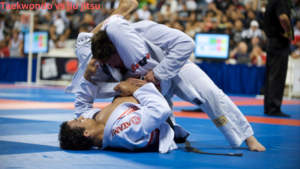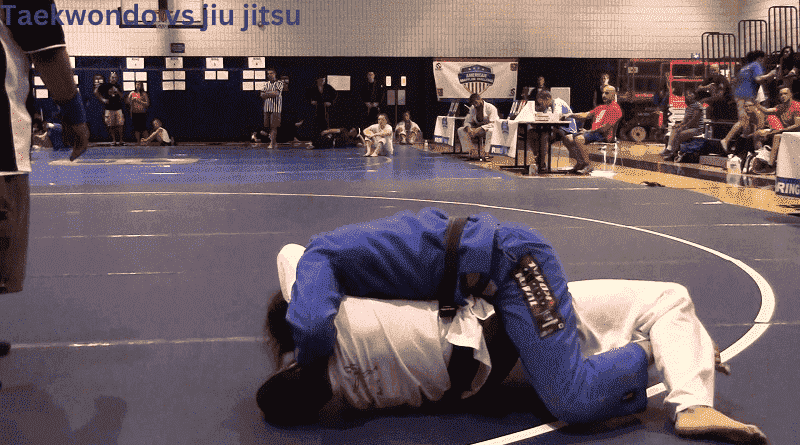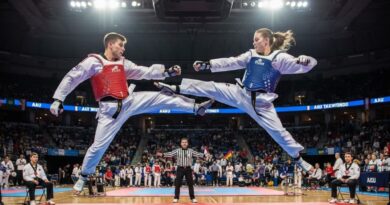Fight Like a Pro: Taekwondo vs jiu jitsu: The Battle of Titans!
Introduction
Within the realm of martial arts, two disciplines stand out for their distinct approaches to combat: Taekwondo vs jiu jitsu. Both ancient martial arts have gained worldwide renown over time, each with its own set of distinctive styles and techniques. We will delve deeply into these ancient art forms, learning their origins, philosophies, fighting styles, and how they stack up against one another in an ultimate battle of titans.
The Origins of Taekwondo
Taekwondo, a Korean martial art, can be traced back to ancient Korea. The name itself reveals its essence: Tae means foot, Kwon stands for fist, and Do refers to way of life. Taekwondo emphasizes high, fast kicks as well as powerful strikes; practitioners are sometimes referred to as “kickers.”
The Origins of Jiu Jitsu
Jiu Jitsu began its roots in Japan during the samurai era and has a rich tradition dating back to ground fighting, submissions, and joint locks, emphasizing technique over brute force. Jiu Jitsu can be defined as a grappling-based martial art that emphasizes ground fighting techniques, submissions, joint locks, and ground fighting techniques as part of ground combat and ground fighting techniques that emphasize ground fighting, submissions, and joint locks, translated to “gentle art.” Philosophy and Principles for Jiu Jitsu
Taekwondo’s Philosophy
Taekwondo emphasizes discipline, self-control, and building strong moral character among its practitioners. Students learn five tenets of Taekwondo: courtesy, integrity, perseverance, self-control, and indomitable spirit, which serve as its philosophical cornerstones.
Jiu Jitsu’s Philosophy
Efficiency and flexibility are key concepts in Jiu Jitsu.
teaching that even smaller, weaker people can successfully defend against larger opponents using proper technique and leverage. Jiu-Jitsu promotes staying calm and patient until the ideal moment to apply submission or escape techniques is available to them. mes
Fighting Styles in Jiu-Jitsu
Taekwondo’s Fighting Style

Taekwondo is known for its dynamic and explosive kicks. Practitioners strive to strike with accuracy and speed using kicks such as roundhouse kicks, side kicks, and flying kicks—essential elements in Taekwondo that keep opponents at a safe distance.
Jiu-Jitsu’s Fighting Style
Innovative close-quarters combat that prioritizes ground fighting is Jiu-Jitsu. Practitioners seek to control their opponents, take them down to the mat, and submit them using joint locks or chokeholds, making it a martial art that excels at grappling and submissions. When it comes to competing on equal footing against one another, these two titans shine brightest!
Striking vs. Grappling
Taekwondo vs jiu jitsu differ significantly in terms of their primary focus. Being a combative art, taekwondo is well-known. While Jiu-Jitsu emphasizes grappling techniques to control opponents. Taekwondo practitioners excel at striking techniques using legs and fists, while grapplers specialize in close-quarters combat using leverage and technique to control opponents and submit them.
Range and Distance
Taekwondo fighters tend to maintain an appropriate distance from their opponents and use kicks of various lengths and velocities as weapons against them. Conversely, Jiu-Jitsu practitioners often quickly close the gap by moving their fight onto the ground, where grappling skills can be put to good use effectively.
Self-Defense and Real-Life Applications
Taekwondo and Jiu Jitsu each boast distinct strengths when it comes to real-life self-defense, whether through strikes or grappling techniques. Taekwondo allows individuals to keep attackers away by striking powerfully, while Jiu-Jitsu provides techniques that subdue attackers without harming oneself in return.
Conclusion
Taekwondo and Jiu Jitsu remain two powerful martial arts with distinct philosophies and fighting styles that suit various preferences and situations, so choosing between Taekwondo and Jiu Jitsu ultimately comes down to personal goals and interests.
Are you ready for martial arts training?
No matter which martial art you practice—Taekwondo or Jiu Jitsu—both offer valuable lessons in discipline, self-defense, and personal growth.
(FAQs),
1. Which martial art should I choose for self-defense purposes?
Both Taekwondo and Jiu Jitsu can serve as effective forms of self-defense; Taekwondo emphasizes striking from a distance. While Jiu Jitsu excels in close-quarter combat and ground defense; it all depends on personal preferences and circumstances.
2. Are one or the other martial arts more physically taxing?
Both Taekwondo and Jiu Jitsu require physical fitness and conditioning. Taekwondo emphasizes agility and explosive power, while Jiu Jitsu emphasizes strength and endurance for grappling.
3. Can I learn both Taekwondo and Jiu-Jitsu simultaneously?
While it is possible to cross-train in both martial arts simultaneously, doing so may prove challenging due to their different techniques and philosophies. Many martial artists prefer specializing in one and building proficiency in another over time.
4. Do Taekwondo vs jiu-jitsu offer competitions?
Both disciplines feature competitive circuits with tournaments and championships dedicated to their sport; Taekwondo competitions focus on point-based sparring. While Jiu-Jitsu tournaments involve grappling and submission matches.
5. How long does it take to become proficient in Taekwondo or Jiu-Jitsu?
It varies depending on each individual, though it often takes several years of consistent practice and dedication before reaching high levels of skill in either martial art.



